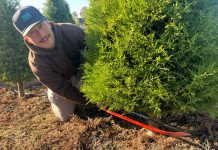Farming near suburbs makes a tough living
Drive down some streets in Hollister and it can look rural on
one side and suburban on the other. Rapid housing growth in the
’80s and ’90s changed the face of San Benito County. Hollister is
no longer the small, rural community it once was, a phenomenon that
has brought some agricultural operations into conflict with nearby
residents.
Farming near suburbs makes a tough living
Drive down some streets in Hollister and it can look rural on one side and suburban on the other. Rapid housing growth in the ’80s and ’90s changed the face of San Benito County. Hollister is no longer the small, rural community it once was, a phenomenon that has brought some agricultural operations into conflict with nearby residents.
“The bigger farms that are on the edge of town, the town grew out to them,” said Paul Matulich, agricultural commissioner for San Benito County.
As Hollister grew, some people quit farming and sold their land for development, Matulich said.
“They didn’t want to fight the neighbors about spraying and noise and dust and all different kinds of aspects,” he said.
The Guerras, a family that has been farming in the county for five generations, stopped farming two parcels in town, the future Legacy Village site and a 20-acre parcel on Apricot Lane near R.O. Hardin Elementary School, said Frank Guerra.
Legacy Village is a planned development with Lowe’s as an anchor store. The parcel was planted with walnut trees until four or five years ago, Guerra said.
“It’s just really difficult when you’re in an urban setting like that,” he said. “It’s just really difficult to bring the crop to harvest. Legacy Village is a prime example. We would irrigate, we would prune, we would thin.”
Before the walnuts were even ripe for harvest, the trees would be stripped, with all their fruit stolen, Guerra said.
“They don’t think of it as stealing either,” said Joe Tonascia, owner of Tonascia Farms and Bertuccio’s Fruit Stand. “The problem is people out there tend to forget that guy out there is trying to make a living, too.”
Tonascia farms next to Ladd Lane Elementary School and Gabilan Hills Elementary School.
“It’s nothing to see people push their cart with a child in it and it’s posted that I just sprayed,” Tonascia said. “Why would you even want to be there?”
People used to throw garbage in the field that will be Legacy Village, Guerra said.
“You end up with all these extra problems,” he said. “We could still be farming there.”
But it was no longer cost effective, he said.
“This urban/rural interface deal, its been a topic in the agricultural industry for the last 10, 12 years,” Matulich said. “A lot of rules and regulations have been adopted to stress safety when you’re next to an urban area.”
The biggest challenge is pesticide application, Matulich said.
“They’re going to have to make special allowances for safety,” he said. “You’ve got to leave a buffer area which is anywhere from 100 to 500 feet away from houses or schools.”
Spraying passing cars with pesticide is a violation, Matulich said.
“Once the wind starts blowing, unless they’re out in the middle of nowhere, they’ll quit spraying until the next day,” he said.
That is why farmers apply pesticide in the middle of the night or early in the morning, Guerra said.
“But then you’ve got noise and the police come down,” Guerra said. “The police are like, ‘What are you doing? You’re making all that noise.'”
That happened at Apricot Lane. The family took the field out of production after a subdivision was constructed nearby, he said.
“[Spraying] causes quite a lot of noise,” Guerra said. “You have to get the spray 30, 40 feet into the trees. I’m talking about a tractor pulling a spray rig. You can hear it from a long distance off.”
They only sprayed three or four times a year, he said.
“If you’re a farmer, or you live in an agricultural area, you get accustomed to it,” Guerra said. “Obviously, if you live out in the country, you know Joe Blow is spraying today and you just go back to sleep.”
Newer residents are not accustomed to the disturbance.
“People, when they move here, they knew that they were moving into a farming community and would be living next to farmers,” Matulich said. “Farmers start early and get their work done.”
Tonascia tries to be courteous of his neighbors, he said.
“You have to time your work around the school schedule a lot of times,” Tonascia said.
San Benito County is an agricultural community and Hollister residents are proud of their agricultural heritage, said Maxine Carlson, principal of Ladd Lane Elementary School.
“It has been a really wonderful benefit to have a farmer as a neighbor, and it’s a beautiful view,” Carlson said. “I wish all the schools could have that experience because it’s just been a real asset to the school.”
It used to be that everybody used to know somebody who worked in agriculture, Tonascia said.
“Nowadays, people are so far removed,” Tonscia said. “They just perceive, when they see a spray rig, that something dangerous is happening. I’ve had people call the air pollution control board because I’m working the ground [and there is] dust.”
Residents of a subdivision near the parcel on Apricot Lane requested several days notice before pesticide application due to an allergy and county officials made it a requirement, Guerra said.
“There was this infestation that went into the houses,” Guerra said. “These little tiny bugs. People started complaining. The same people who were worried about pesticides were requesting that we go in and spray because it was a problem.”
The infestation was from a neighboring field that somebody let go, Guerra said.
“A lot of farmers have gone to less toxic materials over the years to avoid any problems with neighbors,” Matulich said. “Some of the sprays have high odors so they put perfume in the tanks to eliminate the pesticide smell.”
It helps to have a buffer between neighbors and his operation, said Gary Gonzales, owner of Gonzales Orchards, who grows eight acres of apricots and walnuts on Westside Road.
There is more than 800 feet between his operation and his neighbors, Gonzales said.
“I’m not really that close to town yet that I really have to worry about spraying,” Gonzales said. “I used to farm between Westside Road and Union Road, but that wasn’t a problem years ago.”
Gonzales used to farm 15 acres on Ladd Lane.
“Even though I have organic pesticides, people don’t want to see things coming towards them,” Gonzales said.
The location never prohibited him from farming, Gonzales said.
“It wasn’t a big deal once I got accustomed to the school there and all the people,” Tonascia said. “You just have to be aware of when you spray.”
Guerra had other problems on Apricot lane.
“You’d prep the ground and people would ride dirt bikes through there and ruin the ground,” Guerra said.
Tonascia agreed.
“That stuff happens all the time,” he said. “For some reason, when people see opened space, they think that they can ride around on it.”
When there is a problem with neighbors, Tonascia discusses it with them, including school officials.
“They’ve made a very good effort of trying to be good neighbors also,” Tonscia said. “Communication is definitely key.”
Rising land values itself does not create a financial disincentive for farmers, Guerra said. The problem is that they cannot make money by farming the land, he said.
“As people got closer to the orchards, the problems got bigger,” Guerra said. “That’s all a part of it. Any one of them doesn’t do it, but you add them all and all of a sudden it tips the scales. I don’t know if you can blame society – people got worse – or town just got closer.”










